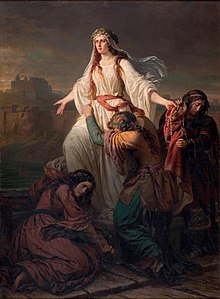Wanda (Dvořák)
| Work data | |
|---|---|
| Title: | Wanda |
| Original title: | Vanda |
| Shape: | Opera in five acts |
| Original language: | Czech |
| Music: | Antonín Dvořák |
| Libretto : | Václav Benes-Sumavsky |
| Literary source: | Julian Surzycki |
| Premiere: | April 17, 1876 |
| Place of premiere: | Národní divadlo , Prague |
| Place and time of the action: | Poland , 10th century |
| people | |
|
|
Wanda (op. 25, Vanda in Czech ) is a tragic opera in five acts by Antonín Dvořák . It was created from April to December 1875 . With the first performance on April 17, 1876 , Rudolf Wirsing opened his term as director of Prague's Prozatímní Theater.
action

The Polish prince's daughter Wanda fights passionately against Roderich, a German prince, and plunges into the waves of the Vistula to save her country. Above all, the struggle between the pagan Slavs and the Christian Germans was worked out. Some motives, such as the quarrel between the applicants for the hand of the ruler, the choice of the husband and the ruler from a low level and the transfer of government power from woman to man, are related to the Bohemian legends about Princess Libuše .
layout
Instrumentation
The orchestral line-up for the opera includes the following instruments:
- Woodwinds : two flutes (including piccolo ), two oboes (also cor anglais ), two clarinets , two bassoons
- Brass : four horns , two trumpets , three trombones , tuba
- Drums
- harp
- Strings
music
In the foreword to the critical first edition, Alan Houtchens refers to the “harmonic richness”, the “colorful instrumentation”, “fine and transparent texture” and the “rhythmic liveliness” of Dvořák's music. Certain themes recur in the course of the opera in many different ways in diverse contexts. The arias, ensembles, dances and choirs form larger scene complexes in the style of the French grand opéra .
Work history
The authorship of the libretto is not completely clear. Václav Benes-Sumavsky and Frantisek Zákrejs were named on the title page of the printed textbook and in the press of the time. The manuscript template comes from the Warsaw professor Julian Surzycki, who is otherwise not a writer. Since it is unlikely that Dvořák set a libretto by an author completely unknown to him, the assumption was made that the real author wanted to keep his identity secret for political reasons. A non-Slavic model could also have prevented the opera's success.
The premiere production saw only four other performances during the season 1876/77 before it was removed from the program. Under Jan Nepomuk Mayr, Wirsing's successor in the office of director, there were four more Wanda performances in 1880, albeit in a drastically shortened version. Both productions lacked singing capacities and adequate stage facilities to properly perform the work. Planned performances like in Vienna or Budapest were not realized.
In 1881 August Alwin Cranz acquired the publishing and, in some cases, the performance rights from the composer.
In the 20th century the opera was staged three times, but not in the original version. In 1925 it was played in Pilsen . The National Theater in Prague took them on in 1929. Finally there was a production in Olomouc in 1989 .
The German premiere took place on March 15, 2014 at the Osnabrück Theater in a production by Robert Lehmeier.
Sources
Dvořák probably sent the autograph score to Leipzig in 1883 . There it appears to have been destroyed in an Allied bombing raid in early December 1943.
A certified copy by a Cranz copyist that still exists shows many serious discrepancies with the original performance material, which are likely to result from corrections made by Dvořák himself around 1900. On the occasion of his 60th birthday in 1901, a cycle of his operas was planned for the National Theater. However, under time pressure, he was only able to fix some of the most obvious mistakes. Most of his changes and improvements can be deciphered in the existing score, which Cranz sent him instead of the autograph.
However, additional additions or complete etchings made during the past 20 years made many of his corrections illegible. The most serious changes in the dramaturgical and musical sequence, however, resulted in the decision of the opera director Edmund Chvalovsky and the conductor Adolf Cech to bring a new production to the stage in 1880.
With the exception of a libretto printed at the time of the premiere, all the primary sources for the opera are only available as manuscripts. Only three individual numbers from the opera have been published to date, including the new overture that Dvořák composed towards the end of 1879 for the revised version of the 1880 production in the Prozatímní Theater.
A new edition initiated by the conductor Gerd Albrecht contains all additions and changes that Dvořák himself made over the 25 years from its premiere in 1876 to 1901. Albrecht, who has already recorded the Dvořák operas Dimitrij and Armida , had parts of the score reconstructed from the original orchestral parts.
Web links
- Vanda : Sheet music and audio files in the International Music Score Library Project
- Work data on Vanda based on MGG with discography at Operone
Individual evidence
- ↑ a b c d e f g h i j Alan Houtchens: Foreword to the critical first edition of the Alkor Edition ( Memento of July 3, 2008 in the Internet Archive ).
